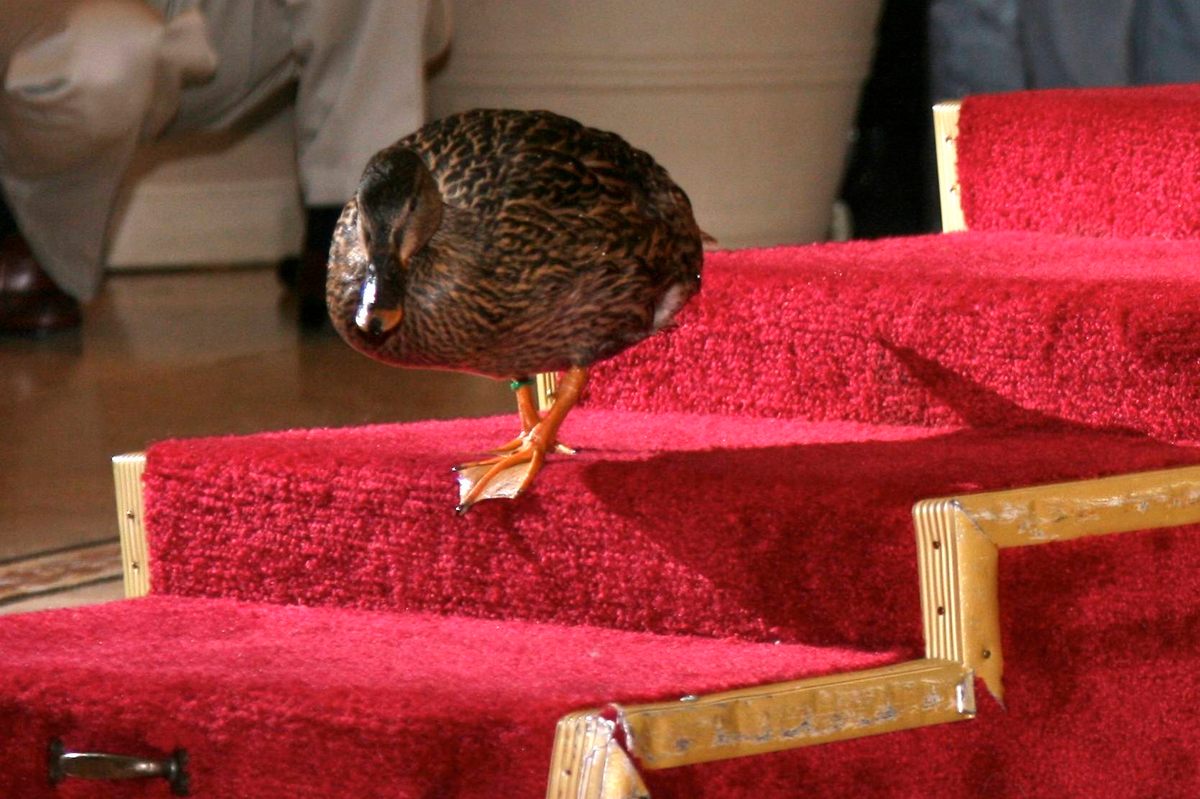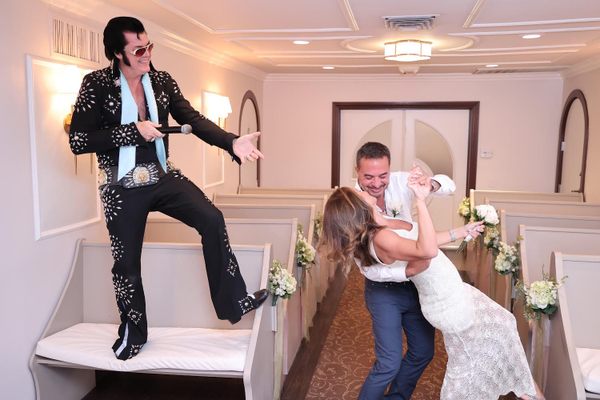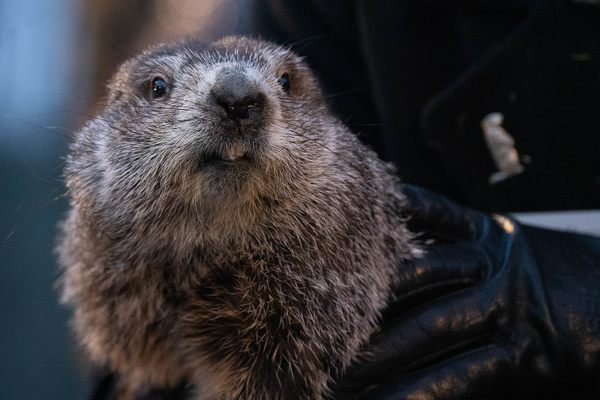What It Takes To Be This Luxury Memphis Hotel’s ‘Duckmaster’
Every duck march needs its duckmaster.
It’s almost 11 a.m. at the Peabody hotel in Memphis, Tennessee, and a crowd has gathered in the elegant, oak-paneled lobby. Suddenly, the sound of a marching band comes booming across the hotel’s speakers, and all eyes turn toward the main elevator. When its gleaming brass doors open, out steps a man in a splendid red and gold uniform, followed by five waddling ducks. The dapper man flourishes his duck-headed cane, and the fowl fall in line strutting supermodel-like toward the lobby’s central fountain where they hop in for a swim.
The feathered celebrities are the Peabody Marching Ducks, VIP guests of the luxury hotel where Elvis was too shy to dance at his prom and where quirk is just as important as quality. Since 2019, actor and historian Kenon Walker has been the ducks’ caretaker, holding one of the world’s most unique jobs: the Peabody Duckmaster™. Walker (who’s known as @duckmasterkenon to his 30,600 TikTok followers) leads his charges everday to and from the lobby fountain, a ritual that started at the Peabody in 1933.
Atlas Obscura spoke to duckmaster Walker to ask him how he came to his extraordinary role, which he believes is his destiny. We also get the low-down on how ducks became an attraction at the historic hotel and learn how Tennessee whiskey played a part in it.
How did you become the Peabody’s duckmaster?
It was not my plan. Duckmaster wasn’t on the list of things I thought I’d grow up to be. I’m an actor and historian and was working at the Peabody as a concierge when their duckmaster, Doug Weatherford, who was about to retire, recognized how well I interacted with people.
He told me I had what it took to be a duckmaster and asked me to give it a try. Initially, I said “no,” but Doug persisted. When he asked me for the seventh time, I thought “Wow, you’re adamant.” I prayed about it that night and woke up the next morning with a complete sense of peace about it. As a performer, a public speaker, and a father, there was a certain level of excitement about it.

How did the Peabody’s duck march start?
The tradition began in the 1930s. Frank Schutt, the Peabody’s manager back then, and his friend returned from a hunting trip. After a little too much Jack Daniel’s Tennessee whiskey, they let their live duck decoys swim in the Peabody fountain.
The birds’ reaction was nothing short of enthusiastic, and since then there have always been five North American Mallards swimming in the fountain.
Is it always the same ducks?
Always North American Mallards, always four females, one male. We rotate them every three months so they don’t become too accustomed to a lavish lifestyle. Then, they retire at a Tennessee farm.
The biggest part of my job is to not become attached. We don’t name the ducks. We don’t treat them as pets but as the wild animals they are.
How did the role of duckmaster come about?
The ducks were a fixture in the fountain for nearly a decade when they hired former circus animal trainer Edward Pembroke in 1940 as a bellman who also helped deliver the ducks to the fountain. Pembroke conceived the now-famous “Duck March” and remained the duckmaster for 50 years.

What are some of the funniest moments you’ve had on the job?
With new ducks, you never know what to expect. We’ve had them head for the bathrooms, the kitchen, the gift shops—even the bar. Occasionally, they get “twitterpated” [Walker’s child-friendly word for when the ducks get frisky and attempt to, or do, actually mate] and the kids ask why the male is “jumping” on the female.
“They’re just playing a game” or “he’s just scratching the part of her back that she can’t reach” are my usual replies. I’ve had conversations with the ducks about reserving certain activities for after the 5 o’clock show, but they’re wild animals at the end of the day.
Is it true that the ducks live in a rooftop palace?
Yes, with various enrichment features. A nesting box replica of the hotel, grassy areas, and a fountain means they can do what wild ducks naturally do. They love to swim at all hours. The fountain allows them to dunk their heads underwater to blow out their nasal passages.
They forage in the grass for food and bugs and as ducks prefer small, private places to sleep, the box is their happy place.

Describe a typical day in the life of the Peabody duckmaster.
We start with a wake-up call and breakfast in bed for the ducks, this is a hotel after all. Then I clean the palace; at 10:30 a.m., I roll out the red carpet, greet the crowd, and then fetch the ducks for the march. At 11:20 a.m., they’re served breakfast on a silver platter, and at 11:30 a.m. my hotel history tour begins.
12:45 p.m. is the duckmaster’s lunch break, then it’s a palace deep-clean. At 4:30 p.m. I roll out the carpet again for the march back to the rooftop.
At 5 p.m., I put the ducks to bed.
How do you train a duck to ride an elevator?
We walk back and forth across the rooftop until they trust me. Then, I ask them, politely, of course, to go in the elevator. It’s all about repetition. Duck palace, elevator; duck palace, elevator. After a while, they’re leading me.
After doing this successfully a few times, we ride down. There’s no training for the red carpet moment, but with people lining either side up to the fountain the ducks soon find their way.

What is your most memorable reaction from a visitor to the ducks?
There was a man who arranged to march the ducks with me on behalf of his late wife. They had loved watching the duck march videos together on TikTok and it was her dream to see them in person, but she died before she was able to. He came wearing the suit that he got married in; he had their son with him holding her picture. When I learned his story, I was so moved and when I introduced him, I was emotional. I told the onlookers their beautiful story and there wasn’t a dry eye in the entire lobby.
We marched the ducks then went up in the elevator as the sun was setting. I put the ducks in their palace and watched the sunset with the man and his son. When it set, he said, “Baby, we did it.”














Follow us on Twitter to get the latest on the world's hidden wonders.
Like us on Facebook to get the latest on the world's hidden wonders.
Follow us on Twitter Like us on Facebook